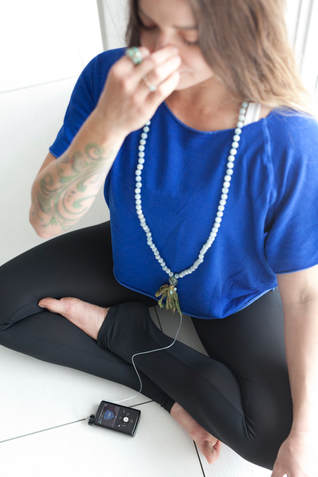|
Yoga taught me to turn my whole life into a practice, especially type 1 diabetes. This simple mind-shift helped me to see that living with type 1 diabetes and hypothyroidism is a beautiful and curious practice of yoga. However it is easier said than done. I am not immune to challenges. The last few weeks I have been struggling to get my blood sugars in check. Every time I notice that my numbers are off I reason the direct cause of the imbalance. Here’s the step-by-step question analysis:
Through this scientific deduction process I usually can discover the cause of my imbalance. But what happens when you still can’t figure it out? It is so frustrating! It can lead to diabetes burnout, fatigue, anxiety and ultimately depression. The answer to mastering your condition and rising above the highs and lows is turning your experience into a practice. Yoga therapy is a science of deductive reasoning through sva-dhyaya or self-awareness. In this video I will go over my top 6 steps to help you increase self-awareness, promote clarity when you are confused and become non-reactive in the face of the most frustrating diabetes ruts. Learn my top yoga therapy action steps to get out of your diabetes rut now and in the future.
0 Comments
Last week's video was all about the vagus nerve and how stimulating it can improve your stress response, lower your heart rate, increase circulation, digestion and decrease insulin resistance. The vagus nerve is responsible for your body's innate power to SELF HEAL. It's no secret that type 1 diabetics are susceptible to overwhelm, anxiety, depression and it takes longer for us to recover. Stimulating the vagus nerve is an essential self-care ritual that should be a part of your daily practice. This week I am going to show you how stimulate the vagus nerve and increase your ability to heal from the inside out. Whether your goal is to promote more internal homeostasis, be less reactive to external stimuli, have more energy for adventures, family and personal pursuits. The work starts here with breathing. If you are short on time: 1:48 Explanation of how to breathe 2:40 Breathing practice begins The science of yoga and diabetesSome of most common daily side effects of type one diabetes are insulin resistance, anxiety and gastro-intestinal distress. Left untreated these common issues can turn into bigger problems like retinopathy, depression, heart disease and gastroparesis.
There is no cure just yet but in the meantime there is a simple and powerful way to improve and even resolve these common side effects with yoga. The answer is vagal tone. The vagus nerve is the tenth cranial nerve, the longest in the body. It is also known as the "wandering nerve" and connects the brain to the heart, lungs, diaphragm, stomach and digestive tract. By toning the vagus nerve you can improve your stress response, increase circulation and reduces heart rate, inflammation and insulin resistance. Not to mention a healthy vagus nerve elicits parasympathetic response improving your brain function, reducing anxiety, depression and giving you the strength to recover sooner from the side effects from hyper and hypoglycemia. Naturally yoga therapy is more parasympathetic. In this short 10 minute video you will learn:
Lead With Love in Aspen, Colorado is a unique opportunity to celebrate all forms of yoga from the physical practices to the people who live the philosophy and transform the world. The festival has hosted keynotes like Marianne Williamson, Deepak Chopra, Seane Corn, Richard Branson and Rod Stryker. The combo of practice and integration makes Lead with Love a worthwhile destination for anyone who seeks to learn from great masters of their trade. Gina Murdock, Lead with Love Founder is a visionary inspiration. I have personally known Gina for years from working in the Aspen yoga community and believe in her mission to transform our community, minds and hearts for the better.
Her team have a mission to take the original Aspen Idea which is to live a life inspired by human potential and educate as many people as possible about how to make that happen. This exclusive yet inclusive experience stands out in the sea of Colorado yoga festivals because its intention is singular: to live a life inspired by love. It is this direct understanding of what it is to be love, to give love and to lead our businesses from love and our relationships from love that changes the world. Lead with Love is not all about yoga asana. The event consists of masterful yoga practices, pranayama workshops (lead by yours truly) but also and more interestingly incredible speakers who inspire your mind and touch your soul. These talks are perhaps the most vibrant and transformational of all the retreats experiences. I am honored to be a part of this festival for the second year in a row. Join me for a pranayama workshop and lecture on yoga therapy for chronic illness sponsored by Almeda. Use promo code EVANLOVE for $100 off the 4-day retreat at the Aspen Meadows. Please join me and the whole Aspen yoga community for this not to be missed experience. In yoga philosophy and important concept is the idea of seer and seen. You the subject are observing an object. This object can be your breath, a symbol, a candle flame or it can be a health condition. In my case, it is type 1 diabetes. The ability to separate yourself from your condition is an essential tool in the journey towards self-mastery. It is a relatively easy concept to understand from an intellectual perspective You have a health condition and it does not define you.Yet it is harder to apply this wisdom when you are in the midst of a challenging moment. When I can establish an awareness that I am observing the thoughts, sensations and feelings but that those things are not me it helps me to respond better to the highs and lows. If I am not aware the impulse to act and react to the thoughts, sensations and feelings is stronger than me. I may eat too much to treat a low. I can overly inject insulin. I can ignore the warning signs and further perpetuate a vicious cycle of highs and lows. I might not see clearly how my actions are responsible for what I am experiencing and not make appropriate changes. In this week's video you will learn how to:
Yoga Therapy Can Change Your Life Forever. It Did For Me. Isn't all yoga therapeutic? Although the lines between the practice and tradition of yoga may seem blurred, there are some subtle yet important differences between yoga and yoga therapy. Yoga therapy is different from yoga in a few special ways: 1. Yoga Therapy is designed for the individual. What that means is that sessions are created for the person who is practicing. These practices may address a specific health condition or illness. 2. Yoga Therapy pools the wealth of knowledge from yoga tradition and philosophy and intentionally creates practices for specific health concerns. 3.. Yoga Therapy is a form of physical and psychotherapy. With self-study and discipline the practitioner of yoga therapy can overcome all limitations from structural, physiological and self-limiting beliefs. The goal is to be self-functioning and the means is unique to the individual. A yoga therapist takes a formal intake of each client much like a healthcare professional. 4. Yoga Therapy looks at the cause of suffering. If it is a back problem, look at what makes it worse and what makes it better. Apply intervention practices to address the pain. If it is an illness like diabetes yoga therapy looks at behavioral patterns and uses the energetics of physiological balance to help regenerate and restore the body's innate power to heal. 5. Yoga Therapy is uniquely for the practitioner. Although there may be yoga practices and classes that address a specific condition, these practices are generalized for a group. Yoga therapy not only helps to modify and adjust the practices to suit the individual but makes the practice just for the individual who is multi-dimensional. 6. A yoga therapist’s goal is to grant the client independence and to show them how to practice for themselves. A good yoga therapist helps the client understand how they have the power to influence change in their perception and to gain dominion over their life and choices. As a type 1 diabetic for over 20 years I rely on my yoga therapy practice to help me balance the inevitable challenges that follow chronic illness and autoimmune conditions. Yoga therapy is not a substitute for health care it is a supplement which grants the individual the ability to change the course of their lives. We all have challenges to conquer in this lifetime and yoga therapy is a means to live this beautiful life of yours fully. Learn more about starting a yoga therapy practice online with Evan. In order to master type 1 diabetes you need to be disciplined in so many ways. You are not born with the power to be self-disciplined. It is a required skillset that can be refined and strengthened like a muscle. According to yoga tradition, self-discipline (tapas) is a key first step in the practice of living in harmonious balance inside and out. Without it, you cannot acquire the strength to ascend beyond impulses and live freely in your choices. When I was first diagnosed, I lacked self-discipline. My impulses drove most of my choices. When my blood sugars were low, I would over eat. When I felt empty, I would reach toward unhealthy food choices to slake the uncomfortable feeling of not being enough. Self-discipline is not about control. It is about power. The power of choice. When you can choose from a place of knowing versus impulse, you are in charge. In this short video you will learn how to:
|
AuthorEvan Rachel Soroka Archives
November 2021
Categories |
220 West Main St. Unit 202, Aspen, CO 81611 CONTACT 970-618-9042 © COPYRIGHT SOROKA YOGA THERAPY 2021. ALL RIGHTS RESERVED.


 RSS Feed
RSS Feed